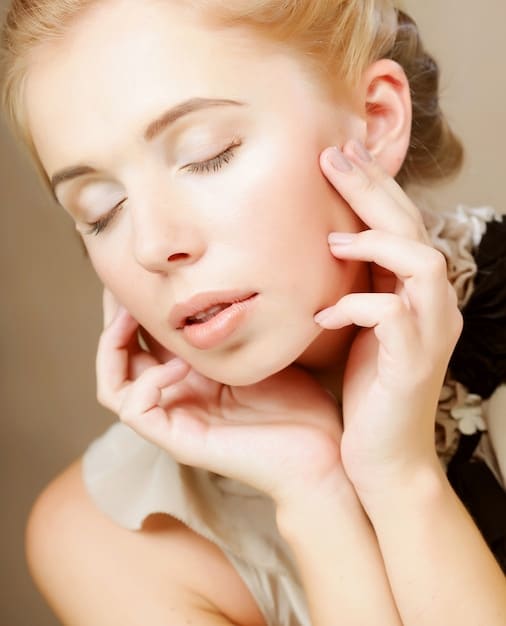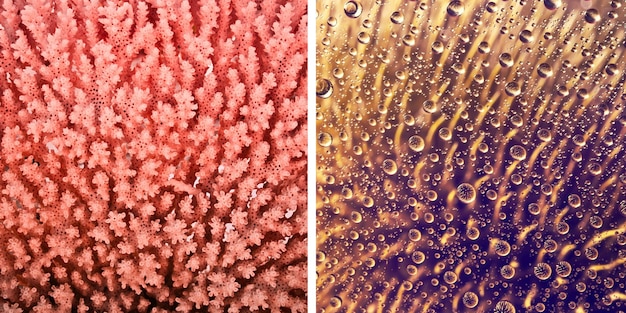Is Your Skincare Routine Aging You? 3 Signs & Solutions

Is Your Current Skincare Routine Aging You? Recognizing signs like persistent dryness, increased sensitivity, and lack of visible results indicates it’s time to reassess and update your skincare approach for a healthier, more youthful complexion.
Is your skin looking older than it should, despite your best skincare efforts? It’s possible your current routine, while well-intentioned, might be unintentionally contributing to premature aging. Let’s explore the telltale signs and how to fix it, because **is your current skincare routine aging you?** It’s a question worth asking.
Recognizing the Signs: Is Your Skincare Routine Aging You?
We all want our skincare routines to keep us looking our best, but sometimes, they can have the opposite effect. It’s crucial to recognize when your efforts are no longer serving you. Identifying the signs of a routine that’s contributing to aging allows you to make necessary adjustments.
Here are three key indicators that it might be time for a skincare update:
Persistent Dryness and Dehydration
One of the most common signs that your skincare isn’t working is persistent dryness. If your skin constantly feels tight, flaky, or uncomfortable, your routine might be stripping away essential moisture.
Increased Sensitivity and Irritation
If you’re experiencing more redness, itching, or burning than usual, your skin may be reacting negatively to harsh ingredients or over-exfoliation.

Sign #1: Chronic Dryness and Dehydration
Dryness often stems from using products with overly harsh ingredients. While these might initially seem effective, they can compromise your skin’s natural barrier, leading to chronic dehydration. Recognizing the signs is vital.
Here’s how to identify and address this issue:
Identifying the Culprits
Ingredients like alcohol, sulfates, and strong fragrances are common culprits behind dryness. They strip the skin of its natural oils, weakening its protective barrier.
The Importance of Hydration
Hydration is key to maintaining youthful, healthy skin. When your skin is properly hydrated, it appears plumper, smoother, and more radiant.
- Switch to a gentle, hydrating cleanser.
- Incorporate a hyaluronic acid serum into your routine.
- Use a rich moisturizer that contains ceramides and emollients.
- Consider adding a facial oil to lock in moisture.
Addressing chronic dryness requires a proactive approach. By identifying and eliminating harsh ingredients and focusing on hydration, you can restore your skin’s natural balance and vitality. Pay attention to what your skin is telling you.
Sign #2: Unexplained Sensitivity and Redness
If your skin is suddenly more reactive, it may indicate that your routine is causing irritation rather than soothing it. Sensitivity and redness are often signs of inflammation, which can accelerate the aging process.
Let’s delve into understanding and managing this sensitivity:
Over-Exfoliation Woes
While exfoliation is beneficial for removing dead skin cells, overdoing it can lead to damaged skin. This leaves the skin vulnerable to environmental aggressors.
Aggressive Actives
Certain active ingredients, such as high concentrations of retinol or potent acids, can be too harsh for some skin types, leading to irritation and redness.

Solutions for Sensitive Skin
Managing sensitivity requires a gentle approach. This means avoiding harsh ingredients, opting for calming formulations, and gradually introducing active ingredients.
Here are some strategies:
Opt for Gentle Cleansers
Choose cleansers that are free from sulfates and fragrances. Look for formulations labeled as “gentle” or “for sensitive skin.”
Introduce Calming Ingredients
Incorporate products containing ingredients like chamomile, aloe vera, and green tea, known for their soothing properties.
- Reduce the frequency of exfoliation to once or twice a week.
- Dilute potent serums with a moisturizer to reduce their intensity.
- Always patch-test new products before applying them to your entire face.
Addressing sensitivity requires patience and consistency. By adopting a gentle approach and listening to your skin, you can reduce irritation and promote a calmer, healthier complexion. Remember, less is often more when it comes to sensitive skin.
Sign #3: Lack of Visible Improvement
If you’ve been diligently following your skincare routine for several weeks or months without seeing any noticeable improvement, it’s time to reevaluate. A stagnant routine might be failing to address your evolving skincare needs.
Let’s explore why your routine might be underperforming:
Addressing Specific Concerns
A skincare routine needs to be tailored to your specific concerns. Are you targeting fine lines, hyperpigmentation, or acne? Without addressing these issues directly, you may not see the desired results.
Age-Related Changes
As we age, our skin’s needs change. What worked in your 20s might not be as effective in your 40s or beyond.
Updating Your Routine for Improved Results
To achieve visible improvements, it’s essential to reassess your skincare goals and adjust your routine accordingly. This may involve incorporating new ingredients, switching to more potent formulations, or seeking professional advice.
Here are some steps to take:
Reassess Your Goals
Determine which skincare concerns are most pressing. Are you looking to reduce wrinkles, fade dark spots, or improve skin texture?
Incorporate Targeted Treatments
Add products that contain ingredients specifically designed to address your concerns. For example, retinol for wrinkles, vitamin C for brightening, or salicylic acid for acne.
Seek Professional Guidance
Sometimes, a dermatologist or esthetician can offer valuable insights into your skin’s specific needs. They can recommend products and treatments that are tailored to your skin type and concerns.
- Consider chemical peels or microdermabrasion to boost cell turnover.
- Explore prescription-strength retinoids for more significant anti-aging effects.
- Be patient and allow your skin time to adjust to new products and treatments.
Achieving visible improvements requires a proactive and personalized approach. By targeting your specific concerns and adapting your routine to meet your evolving needs, you can achieve a healthier, more radiant complexion. Remember, skincare is not one-size-fits-all.
Decoding the Ingredients List: What Should You Avoid?
Becoming a savvy skincare consumer involves understanding ingredient lists. Certain ingredients are known irritants or can contribute to premature aging. Knowing what to avoid can significantly improve your skin’s health.
Here’s a guide to some ingredients to be wary of:
Sulfates
Commonly found in cleansers, sulfates can strip the skin of its natural oils, leading to dryness and irritation.
Alcohol
Alcohol-based products can dehydrate the skin and compromise its protective barrier.
Fragrances
Synthetic fragrances are a common cause of allergic reactions and can irritate sensitive skin.
Ingredients to Embrace for Youthful Skin
On the flip side, there are numerous ingredients that can promote youthful, healthy skin. These ingredients often have antioxidant, hydrating, or collagen-boosting properties.
Here are some ingredients to look for:
Hyaluronic Acid
A powerful humectant that attracts and retains moisture, keeping skin hydrated and plump.
Vitamin C
An antioxidant that protects against free radical damage, brightens skin, and promotes collagen production.
- Read product labels carefully and avoid products with harsh chemicals.
- Opt for products labeled as “fragrance-free” or “for sensitive skin”.
- Prioritize products with natural and nourishing ingredients.
Becoming an informed skincare consumer is crucial for maintaining healthy, youthful skin. By avoiding potentially harmful ingredients and embracing beneficial ones, you can create a routine that truly supports your skin’s needs. Always prioritize ingredients that are gentle and nourishing.
The Power of Professional Advice: When to Consult a Dermatologist
While many skincare concerns can be addressed with over-the-counter products and lifestyle changes, sometimes professional guidance is needed. A dermatologist can offer personalized recommendations and treatments for more complex skin issues.
Here’s why seeking professional advice can be beneficial:
Personalized Recommendations
A dermatologist can assess your skin type and concerns to recommend products and treatments tailored to your specific needs.
Advanced Treatments
Dermatologists offer a range of advanced treatments, such as chemical peels, laser resurfacing, and injectable fillers, that can deliver more significant results.
Making the Most of Your Consultation
If you decide to consult a dermatologist, it’s essential to prepare for your appointment. This involves gathering information about your skincare routine, medical history, and specific concerns.
Before your appointment you should:
Compile a List of Products
Bring a list of all the products you’re currently using, including cleansers, serums, moisturizers, and makeup.
Note Your Concerns
Write down any specific issues you’re experiencing, such as dryness, sensitivity, or breakouts.
- Bring photographs of your skin to illustrate the changes you’ve noticed over time.
- Ask questions about potential treatments and their associated risks and benefits.
- Follow your dermatologist’s recommendations carefully and be patient with the results.
Seeking professional advice can be a game-changer for your skincare routine. By working with a dermatologist, you can gain valuable insights into your skin’s needs and develop a personalized plan for achieving a healthier, more youthful complexion. Don’t hesitate to seek professional help when needed.
| Key Point | Brief Description |
|---|---|
| 💧 Persistent Dryness | Indicates need for gentler, hydrating products. |
| 🔥 Sensitivity & Redness | May be caused by over-exfoliation or harsh ingredients. |
| 🤔 Lack of Improvement | Routine might not be addressing specific skin concerns effectively. |
| 🧪 Ingredient Awareness | Avoid sulfates, alcohol, and fragrances; embrace hyaluronic acid and Vitamin C. |
Frequently Asked Questions
▼
The initial signs often include increased dryness, heightened sensitivity, and a general lack of improvement in skin texture or tone. You might also notice more frequent breakouts or redness.
▼
It’s advisable to reassess your routine every 6-12 months, or whenever you experience significant changes in your skin’s condition. Seasonal changes may also warrant adjustments.
▼
Yes, over-exfoliation can compromise your skin’s barrier, leading to sensitivity, redness, and increased risk of infection. It’s crucial to exfoliate gently and not too frequently.
▼
Not necessarily. The effectiveness of a product depends more on its ingredients and formulation than its price tag. Research ingredients and read reviews to make informed decisions.
▼
Consider consulting a dermatologist if you have persistent skin issues that don’t improve with over-the-counter products, or if you suspect a more serious skin condition.
Conclusion
Recognizing the signs that your skincare routine is aging you is the first step toward a healthier, more youthful complexion. By addressing issues like chronic dryness, sensitivity, and lack of visible improvement, and by consulting with professionals when needed, you can create a routine that truly supports your skin’s evolving needs and promotes long-term radiance.





